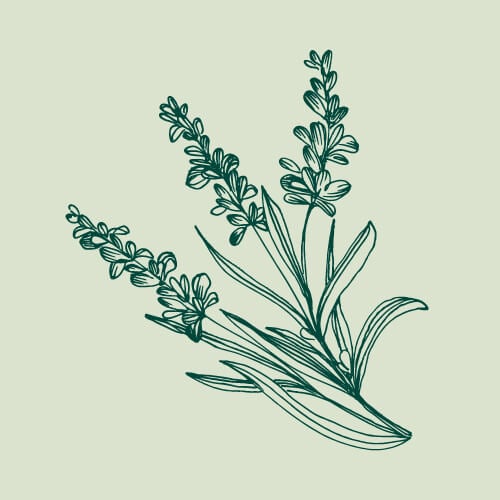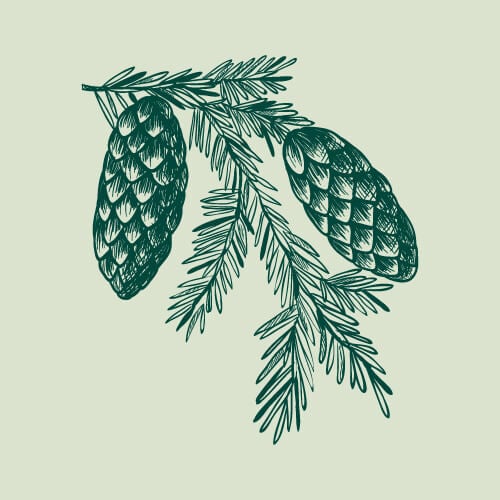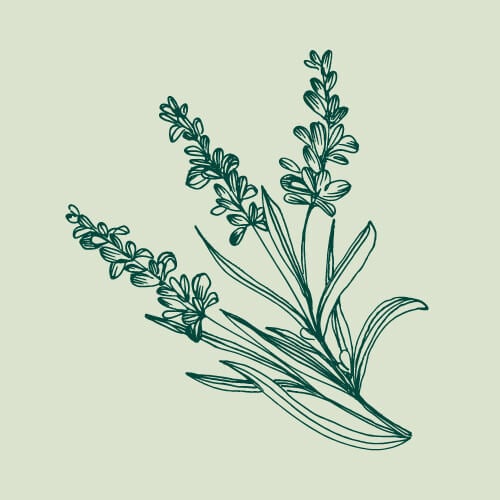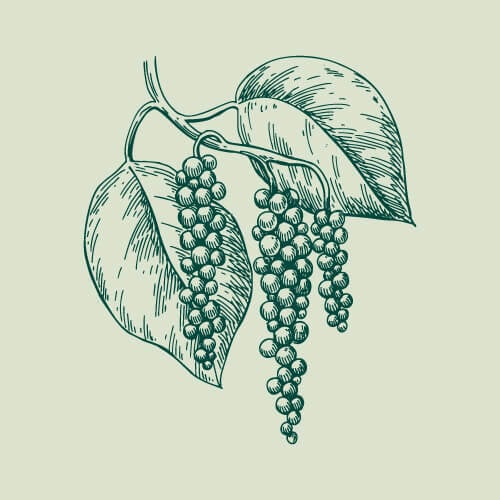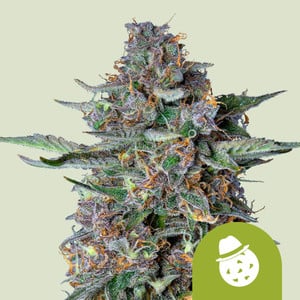.

Linalool: Get to Know This Fragrant Cannabis Terpene
Terpenes add dimension, depth, and diversity to the cannabis experience. Among the upwards of 200 terpenes that weed flowers produce, linalool stands out as particularly fragrant. But its citrusy scents pale in comparison to what ongoing research continues to discover about this fascinating compound.
Contents:
In the past, both cannabis consumers and scientists attributed the effects of marijuana exclusively to cannabinoids such as THC and CBD. However, recent advances in our understanding of the plant show that terpenes—the aromatic constituents chiefly responsible for the flavors and aromas of cannabis—also influence its physiological effects.
Cannabis produces at least 200 of these pungent molecules, but several stand out for their relative abundance in many strains. While linalool doesn’t occur in particularly high concentrations in most cannabis plans, even small amounts have a notable aromatic presence. Furthermore, when isolated, linalool displays some interesting effects that have piqued the interest of researchers. Continue reading to discover the fascinating properties of the linalool terpene.


The Chemistry of Linalool
Chemically, terpenes comprise small building blocks called isoprene units, which are structures containing five carbon atoms, eight hydrogen atoms, and two double bonds. As a monoterpene—featuring just two isoprene units—linalool features a molecular formula of C₁₀H₁₈O, placing it in the structurally smallest class of terpenes and making it highly volatile. The addition of a functional group in the form of an oxygen atom makes linalool a terpenoid—a unique class of terpenes that possess a slightly modified chemical structure.
Interestingly, research suggests that linalool could work similarly to cannabinoids in the body. A paper[1] published in the journal Scientific Reports observed that linalool binds to the CB1 receptor of the endocannabinoid system. As THC and other cannabinoids also bind to this site, it raises the possibility that linalool could synergise with these molecules, contributing to the entourage effect theory.
As mentioned, linalool generally occurs in minor concentrations in most cannabis strains, though certain cultivars contain elevated levels. However, this terpene isn’t exclusive to cannabis, occurring in plants like lavender, basil, cilantro, mint, cinnamon, rosewood, citrus fruits, birch trees, lemongrass, and chamomile as well.
Aroma and Flavor of the Linalool Terpene
Despite mostly showing up in small quantities, linalool contributes to the distinct flavors and aromas of many weed varieties. On the nose, you’ll detect floral notes of lavender, bergamot, spice, wood, and citrus. Meanwhile, the terpene's taste is most accurately described as fruity, zesty, and refreshing, with evident notes of lemon and lime, herbs, and lavender.
Effects Associated With Linalool in Cannabis
Linalool could play a unique role in the overall effects experienced when consuming certain strains. The effects of this terpene are generally described as soothing, potentially enhancing the relaxing influence of cannabinoids like THC. Strains high in linalool are usually associated with feelings of relaxation, bliss, and euphoria. Users often report sensations of inner stillness that help them to access states of meditation and deep contemplation.
Accordingly, linalool-rich strains are often recommended for quiet smoking sessions during the evening. They also make a fine choice during camping trips or slow-paced outdoor excursions.
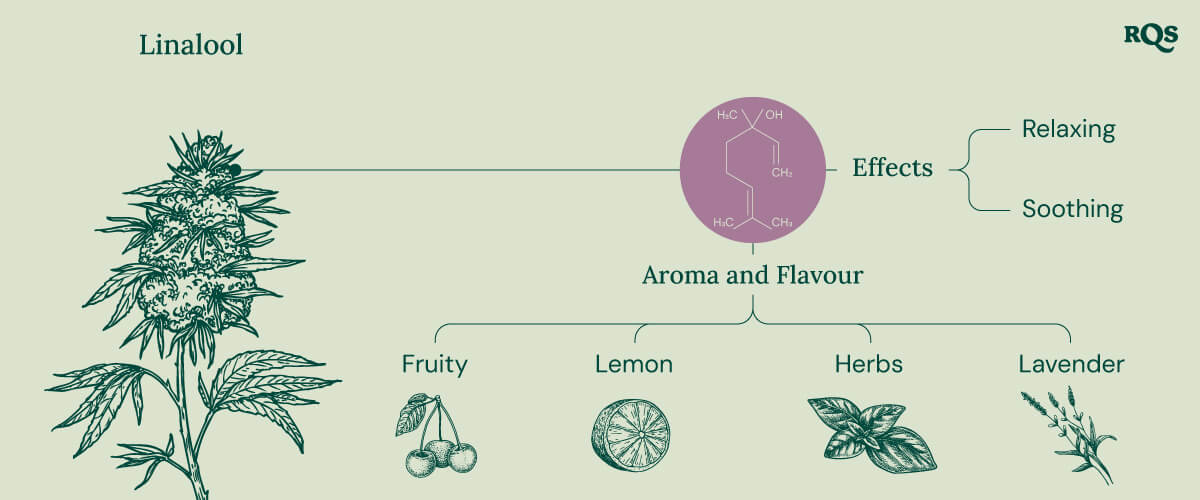
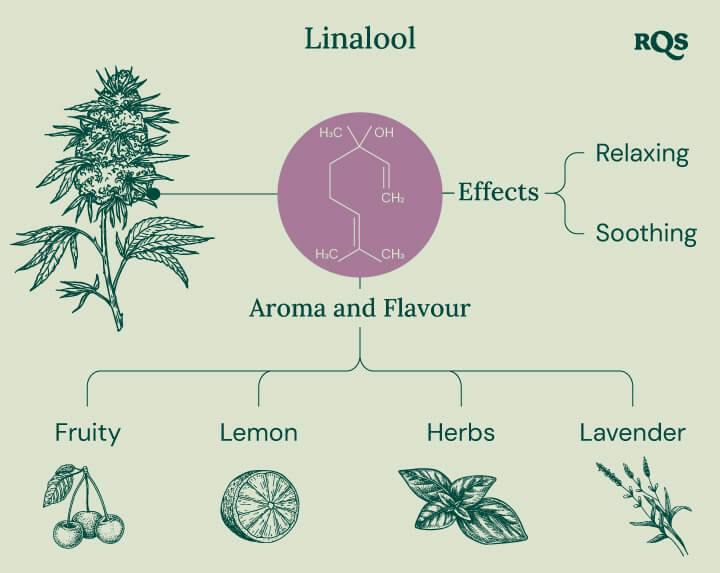
Linalool: A Look at the Research
In the ongoing hunt for novel therapeutics, scientific researchers continue to focus their efforts on terpenes, including linalool, both inside and outside the context of cannabis. Studies have observed the effects of linalool in numerous cell and animal models, and a handful of studies have tested the terpene on humans. However, it’s important to recognize that research on linalool remains early, meaning we can’t draw conclusions from the limited data we have so far. With that in mind, let’s check out what the available science tells us about this refreshing aromatic phytochemical.
-
Antibacterial
Research[2] shows that linalool helps plants to protect themselves from bacterial infection. Left unchecked, certain pathogens gobble up nectar reserves meant to attract pollinators, and impact overall plant fitness. This form of chemical defense has proven effective against slowing bacterial growth in plants, but researchers want to know if it could also inhibit those affecting humans. A 2021 study[3] showed linalool to demonstrate antimicrobial activity against Pseudomonas fluorescens, a bacteria known to cause opportunistic infections in people with compromised immune systems. The researchers concluded, “It was suggested that linalool may be a new potential source of food antiseptics in food systems”.
-
Sleep Deprivation
Early research suggests the effects of the linalool terpene could also influence sleep deprivation. Poor sleep might not seem like a big deal, but it can impact everything from hormone balance and immunity to memory. A 2018 study[4] administered the terpene to sleep-deprived mice before subjecting them to various behavioural tests. The researchers found linalool to significantly improve markers associated with memory loss and behavioural alterations linked to sleep deprivation. The researchers concluded that “The mechanisms through which linalool improves memory loss and behavioural alterations in sleep-deprived mice appeared to be through an increase in the serotonin levels”.
-
Stress & Anxiety
Stress and anxiety not only impact quality of life, but they have real physiological implications, from increased blood pressure to digestion issues. While the current treatments for these conditions help some people, they aren’t able to alleviate the suffering of others. Because of this, research teams are looking into the ability of natural compounds to help ease stress and anxiety, including linalool.
A study[5] published in the journal Frontiers in Behavioural Neuroscience tested the effects of inhaled linalool on mice. The researchers found the terpene to influence anxiety behaviours through GABA transmission—the chief inhibitory neurotransmitter in the brain. The team concluded, “These results provide information about the potential central neuronal mechanisms underlying the odour-induced anxiolytic effects and the foundation for exploring clinical application of linalool odour in anxiety treatments”.
Another study[6] published in the journal Neuroscience Letters administered linalool to rats experiencing restraint stress. They found the terpene to impact both neuropeptide and gene expression in the hypothalamus, a brain region that plays a key role in anxiety disorders.
Three other studies show intriguing results; a 2019 study[7] showed linalool-rich lavender essential oil to increase neurogenesis in mice, a 2018 study[8] showed lavender essential oil to increase social behaviours in mice, and a 2006 study[9] observed the effects of linalool on stress modulation in 24 human volunteers.
-
Depression
Around 5% of the adult population of the world currently suffer from depression, enduring symptoms such as poor concentration, disrupted sleep, low appetite, and hopelessness. A 2022 review of the available literature states that linalool may help to boost key compounds important in the battle against depression, such as brain-derived neurotrophic factor (BDNF). The authors also found data that suggests the terpene can influence monoaminergic and neuroendocrine systems. The authors concluded that “...linalool emerges as a promising bioactive compound in the therapeutic arsenal, capable of interacting with numerous pathophysiological factors and acting on several targets”.
-
Inflammation
Could linalool’s potential also extend to inflammation, a factor that underpins many different diseases? A 2019 study[10] shows that the terpene could help to reverse elevated COX-2 gene expression, an enzyme expressed following inflammatory stimuli that increases the production of inflammatory biomarkers.
Linalool has also been studied in the context of Alzheimer’s disease (AD). Researchers from the University of Antioquia, Colombia administered a dose of 25 mg/kg every 48 hours for three months to a mouse model of the pathology. After examining the data, the team concluded that “...our findings suggest that linalool reverses the histopathological hallmarks of AD and restores cognitive and emotional functions...”.
-
Antioxidant
Oxidative stress plays a central role in the development of many age-related chronic diseases, including cancer, diabetes, arthritis, and cardiovascular diseases. This physiological state occurs when there’s an imbalance between free radical or reactive oxygen species (ROS) and the antioxidants that neutralise them. However, consuming antioxidant compounds can help to restore balance and quell excess free radicals. Researchers are now exploring the role of linalool as a dietary antioxidant that could help to reduce free radical levels in the body.
A 2019 study shows that the administration of linalool influenced cardiomyopathy symptoms in mice exposed to Doxorubicin, a chemotherapeutic drug that increases ROS production in the mitochondria of cells. Further research also suggests that linalool can protect human skin cells from oxidative stress caused by UVB exposure. A human study published in BMC Neurology looked at the effects of inhaled linalool on oxidative stress in patients with carpal tunnel syndrome (CTS), concluding that “Inhalation of linalool increases antioxidative activity…”.
-
Microbiome Regulation
The human microbiome contains trillions of microorganisms, including bacteria, viruses, and fungi. In the gut, these small critters help us to digest food and even bolster our immune system. However, human health can quickly take a hit when the balance of these organisms shifts, leading to a condition known as dysbiosis, which has links to a range of health conditions, including depression and inflammatory disorders.
An animal study showed that the administration of linalool-rich lavender oil managed to maintain gut bacteria balance in broiler chickens. Adding to this, a review published in the journal Molecules found that linalool-containing essential oils could have an antimicrobial effect on pathogenic bacteria in the gut.
Linalool: A Minor Cannabis Terpene With Wide-Ranging Potential
Linalool shows up in small concentrations in most cannabis strains, compared to the likes of caryophyllene, myrcene, pinene, and other abundant terpenes. Despite this, the chemical still adds refreshing flavors and aromas to many cultivars and contributes a relaxing and soothing effect. The fact that linalool also binds to the CB1 receptors of the endocannabinoid system raises major questions about its ability to impact how THC interacts with the body. While the research around this terpene is inconclusive, the available data suggests that linalool is worthy of much more extensive research.
Cannabis Strains High in Linalool
Are you looking to experience the aromas, flavors, and effects of linalool for yourself? Then try out some of these refreshing strains below!
Do-Si-Dos Auto
Sow your Do-Si-Dos Auto seeds directly into 11 l fabric pots to avoid having to transplant them later on in the growing cycle. Your seedlings will reach a height of around 3 cm by the end of the first week. Apply LST during week three to keep your plants compact and stealthy, and move them outdoors into a sunny position. They’ll peak at around 60 cm by the end of veg.
With training, expect your plants to peak at 80 cm during bloom, or 140 cm without. After a total growing cycle of 9–10 weeks, you’ll harvest up to 150 g of gorgeous purple-green buds. Enjoy the citrusy tastes of linalool alongside a relaxing and soothing high.
Do-Si-Dos Auto
|
|
Do-Si-Dos x Cookies Auto |
|
|
12 to 14 oz/m² |
|
|
3 to 4 feet |
|
|
7 - 8 weeks |
|
|
THC: 20% |
|
|
Sativa 35% Indica 60% Ruderalis 5% |
|
|
3 to 5 oz/plant |
|
|
3 to 5 feet |
|
|
9 - 10 weeks after sprouting |
|
|
Calming |
Mazar
This indica-dominant hybrid stems from landrace genetics with roots in Afghanistan. Start seeds indoors in early spring, maintaining an average temperature of 25°C to speed up germination. Mazar takes on a stocky and bushy appearance, so defoliate plants well during the vegetative stage to keep the canopy open and aerated. Move plants outdoors to a sunny spot once all risk of frost has passed. They’ll reach a height of around 120 cm by the end of veg.
Mazar produces dense colas that become encased with a thick layer of trichomes and resin towards the end of the flowering period. Feed your plants well and they’ll offer a return of around 500–600 g/plant in October. After drying and curing your buds, you’ll enjoy a THC content of up to 20% alongside fresh and floral flavors, courtesy of linalool.
Sweet ZZ
Sow your Sweet ZZ seeds into cell trays until they reach a height of 3 cm. Then, transplant them into 15–20 l pots and keep them indoors until the end of week three. Move your containers outdoors into a south-facing position and expect them to peak at around 160 cm by the end of veg.
Your plants will stretch up to 200 cm during bloom, depending on the pot size and training techniques used. Make sure you have enough stash jars to hand to harvest up to 550 g/plant in late September. High levels of linalool contribute flavors of citrus and fruit to this progeny of Grape Ape and Grapefruit.
Sweet ZZ
|
|
Grape Ape x Grapefruit |
|
|
19 to 21 oz/m² |
|
|
3 to 5 feet |
|
|
7 - 9 weeks |
|
|
THC: 22% |
|
|
Sativa 20% Indica 80% |
|
|
18 to 19 oz/plant |
|
|
5 to 7 feet |
|
|
Late September |
|
|
Calming, Stoned |
The Original Z
This award-winning variety descends from parent strains Grape Ape, Grapefruit, and an unknown additional cultivar.Indica dominant in nature, The Original Z maintains a compact and bushy stature throughout the entire growing cycle. Plants quickly pack on foliage throughout early veg, making it important to defoliate and train plants early to prevent mold forming during bloom. Once all risk of frost has passed, this strain does well when planted directly in the ground in fertile soil rich in organic matter. You can expect your specimens to peak at around 100–120 cm by the time bloom swings around.
Expect your plants to stretch during early flowering, before they start to produce compact nuggets. As your plants edge closer to maturity, you’ll detect aromas of citrus permeating the air every time you enter your growing space—a hallmark of high linalool levels. Enjoy big yields in October.
Royal Skywalker
Give Royal Skywalker seeds a nudge in the right direction using the paper towel method to speed up germination. Place sprouted seeds into 15–20 l pots and expect your seedlings to grow to a height of around 7–10 cm by the end of week two. Apply generous levels of nitrogen to spur vegetative growth, and your plants will stand at 80–150 cm by the end of veg.
Your Royal Skywalker plants will peak at 200 cm during early bloom, depending on the pot size you’ve used. Prepare to harvest up to 500–600 g/plant during October. You’ll savour delicious notes of blueberry, citrus, and pepper from these buds as a THC content of 25% starts to take hold of your mind and body.
Royal Skywalker
|
|
Blueberry x Mazar |
|
|
19 to 21 oz/m² |
|
|
3 to 4 feet |
|
|
9 - 10 weeks |
|
|
THC: 25% |
|
|
Sativa 40% Indica 60% |
|
|
18 to 21 oz/plant |
|
|
5 to 7 feet |
|
|
October |
|
|
Clear, Physically Relaxing |
- Cannabis sativa terpenes are cannabimimetic https://www.nature.com
- Bacteria colonising Penstemon digitalis https://pubmed.ncbi.nlm.nih.gov
- Antimicrobial Activity and Proposed Action Mechanism https://www.ncbi.nlm.nih.gov
- Linalool Ameliorates Memory Loss and Behavioral Impairment https://www.ncbi.nlm.nih.gov
- Linalool Odor-Induced Anxiolytic Effects in Mice https://www.ncbi.nlm.nih.gov
- Inhalation of a racemic mixture https://pubmed.ncbi.nlm.nih.gov
- Lavender essential oil ameliorates depression https://pubmed.ncbi.nlm.nih.gov
- Lavandula angustifolia Essential Oil and Linalool https://www.ncbi.nlm.nih.gov
- Depressive disorder (depression) https://www.who.int
- Linalool as a Therapeutic and Medicinal Tool in Depression https://www.ncbi.nlm.nih.gov
- Linalool attenuates oxidative stress and mitochondrial dysfunction https://pubmed.ncbi.nlm.nih.gov



























